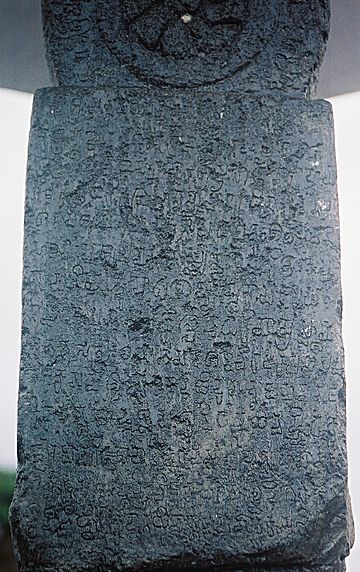The Halmidi inscription is the oldest known Kannada-language inscription in the Kadamba script. While estimates vary slightly, the inscription is often dated to between 450 CE - 500 CE. The inscription was discovered in 1936 by Dr. M. H. Krishna, the Director of Archaeology of the (princely) State of Mysore (present-day Karnataka region of India), in Halmidi, a village in the Hassan district.

The original inscription is kept in the Office of the Director of Archaeology and Museums, Govt. of Karnataka, Mysore,[1] and a fibreglass replica has been installed in Halmidi.
Discovery and dating
In a report published in a Mysore Archaeological Department Report (MAR) in 1936, Krishna dated the inscription to 450 AD, on paleographical grounds.[1][2] Later scholars have variously dated the inscription to 450 AD,[3] 470 AD,[4] 500 AD,[5] "about 500",[6] and "end of the fifth century A. D. or the beginning of the 6th century A.D."[7] Epigraphist, D. C. Sircar has dated the inscription to "about the end of the 6th century."[8]
Epigraphist, K. V. Ramesh has written about the differing estimates:
And I attribute the origin of this doubt in their minds to the fact that scholars, even the reputed ones, have held differing views, mostly to prop up their preconceived notions, on the palaeographical dating of any given undated or insufficiently dated inscriptions. ... The undated Halmidi (Hassan District, Karnataka) inscription, allegedly written during the reign of Kadamba Kakusthavarman, is taken by some scholars to belong, on palaeographical grounds, to the middle of the 5th century AD, while a few other scholars have held, on the same grounds of palaeography, that it is as late as the second half of the 6th century A.D.
— K. V. Ramesh[9]
He also hypothesized that, compared to possibly contemporaneous Sanskrit inscriptions, "Halmidi inscription has letters which are unsettled and uncultivated, no doubt giving an impression, or rather an illusion, even to the trained eye, that it is, in date, later than the period to which it really belongs, namely the fifth century A.D."[10]
Epigraphist G. S. Gai however disagrees with the view that Halmidi is a record of the Kadamba dynasty identified with King Kadamba Kakusthavarman. According to (Gai 1992), the inscription, which is dedicated to "Kadambapan Kakustha-Bhaṭṭōran," refers to another ruler, Kakustha of the Bhaṭāri family, who is explicitly identified in line 13, "baṭāri-kuladōn=āḷu-kadamban;" in addition, the inscription does not "include any of the epithets like Mānavya-gōtra, Hāritī-putra, and most important Dharma-maharājā"[11] that are a part of all Kadamba inscriptions.
Textual analysis

The inscription is in verse form indicating the authors of the inscription had a good sense of the language structure.[12] The inscription is written in pre-old Kannada (Puruvada-hala Kannada), which later evolved into old Kannada, middle Kannada and eventually modern Kannada.[13] The Halmidi inscription is the earliest evidence of the usage of Kannada as an administrative language.[14]
Text


The pillar on which the inscription was written stands around 4 feet (1.2 m) high. The following lines are carved on the front of the pillar:
1. jayati śri-pariṣvāṅga-śārṅga vyānatir-acytāḥ dānav-akṣṇōr-yugānt-āgniḥ śiṣṭānān=tu sudarśanaḥ
2. namaḥ śrīmat=kadaṁbapan=tyāga-saṁpannan kalabhōranā ari ka-
3. kustha-bhaṭṭōran=āḷe naridāviḷe-nāḍuḷ mṛgēśa-nā-
4. gēndr-ābhiḷar=bhbhaṭahar=appor śrī mṛgēśa-nāgāhvaya-
5. r=irrvar=ā baṭari-kul-āmala-vyōma-tārādhi-nāthann=aḷapa-
6. gaṇa-paśupatiy=ā dakṣiṇāpatha-bahu-śata-havan=ā-
7. havuduḷ paśupradāna-śauryyōdyama-bharitōn=dāna pa-
8. śupatiyendu pogaḷeppoṭṭaṇa paśupati-
9. nāmadhēyan=āsarakk=ella-bhaṭariyā prēmālaya-
10. sutange sēndraka-bāṇ=ōbhayadēśad=ā vīra-puruṣa-samakṣa-
11. de kēkaya-pallavaraṁ kād=eṟidu pettajayan=ā vija
12. arasange bāḷgaḻcu palmaḍiuṁ mūḷivaḷuṁ ko-
13. ṭṭār baṭāri-kuladōn=āḷa-kadamban kaḷadōn mahāpātakan
14. irvvaruṁ saḻbaṅgadar vijārasaruṁ palmaḍige kuṟu-
15. mbiḍi viṭṭār adān aḻivornge mahāpatakam svasti
The following line is carved on the pillar's left face:
16. bhaṭṭarg=ī gaḻde oḍḍali ā pattondi viṭṭārakara
See also
Notes
References
External links
Wikiwand in your browser!
Seamless Wikipedia browsing. On steroids.
Every time you click a link to Wikipedia, Wiktionary or Wikiquote in your browser's search results, it will show the modern Wikiwand interface.
Wikiwand extension is a five stars, simple, with minimum permission required to keep your browsing private, safe and transparent.
